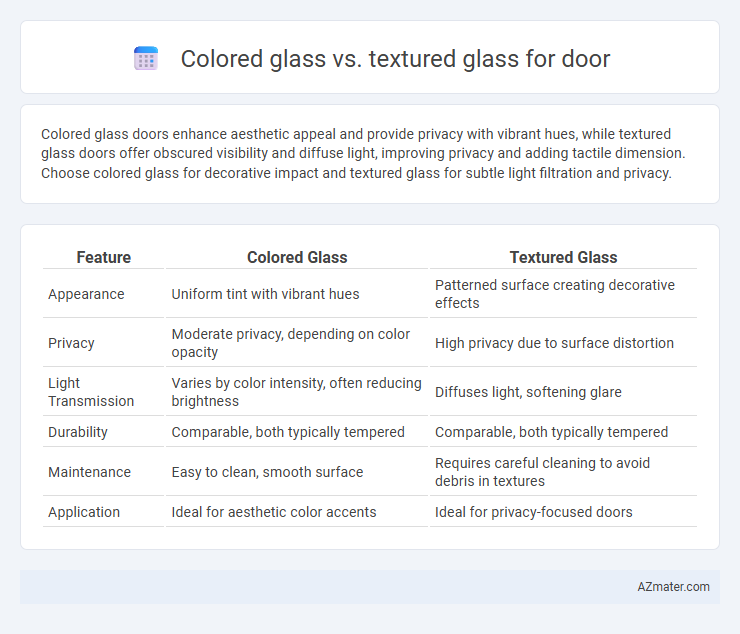Colored glass doors enhance aesthetic appeal and provide privacy with vibrant hues, while textured glass doors offer obscured visibility and diffuse light, improving privacy and adding tactile dimension. Choose colored glass for decorative impact and textured glass for subtle light filtration and privacy.
Table of Comparison
| Feature | Colored Glass | Textured Glass |
|---|---|---|
| Appearance | Uniform tint with vibrant hues | Patterned surface creating decorative effects |
| Privacy | Moderate privacy, depending on color opacity | High privacy due to surface distortion |
| Light Transmission | Varies by color intensity, often reducing brightness | Diffuses light, softening glare |
| Durability | Comparable, both typically tempered | Comparable, both typically tempered |
| Maintenance | Easy to clean, smooth surface | Requires careful cleaning to avoid debris in textures |
| Application | Ideal for aesthetic color accents | Ideal for privacy-focused doors |
Introduction to Decorative Glass for Doors
Colored glass for doors enhances aesthetic appeal by adding vibrant hues and artistic patterns, creating a striking focal point in any space. Textured glass offers privacy and diffuse light diffusion while maintaining natural brightness, ideal for entryways requiring subtle design elements. Both options improve door functionality by combining decorative charm with practical benefits tailored to interior and exterior design needs.
Key Characteristics of Colored Glass
Colored glass for doors offers vibrant hues achieved through the addition of metal oxides or chemical compounds during manufacturing, providing both aesthetic appeal and enhanced privacy. It filters natural light, creating a warm ambiance while maintaining translucency, and is often more customizable in terms of color intensity compared to textured glass. The durability and UV resistance of colored glass make it ideal for exterior doors, combining functionality with decorative elements.
Key Characteristics of Textured Glass
Textured glass for doors offers distinct privacy by obscuring visibility while allowing natural light to pass through, making it ideal for spaces requiring both illumination and discretion. Its unique surface patterns enhance aesthetic appeal and reduce glare compared to colored glass, which primarily adds visual color but may compromise transparency. Textured glass also provides superior scratch resistance and easier maintenance, contributing to its durability and long-term functionality in door applications.
Aesthetic Appeal: Color vs Texture
Colored glass doors offer vibrant hues that enhance visual impact, creating a focal point with bold or subtle tones tailored to interior or exterior design themes. Textured glass, by contrast, adds depth and dimension through patterned surfaces that diffuse light while maintaining privacy, resulting in an understated yet sophisticated aesthetic. The choice between colored and textured glass hinges on desired visual effect--color commands attention with dynamic energy, whereas texture emphasizes tactile interest and nuanced light interplay.
Privacy and Light Transmission Comparison
Colored glass offers moderate privacy by obscuring clear visibility while allowing substantial light transmission, making it ideal for areas needing natural illumination without compromising discretion. Textured glass enhances privacy significantly due to its patterned surfaces that distort images, reducing visibility more effectively than colored glass, yet it may slightly reduce the amount of light transmitted. Selecting between colored and textured glass depends on balancing the desired privacy level and natural light needs for door installations.
Durability and Maintenance Considerations
Colored glass doors offer enhanced durability due to their tint, which helps resist fading and minimizes visibility of scratches, requiring minimal maintenance primarily involving gentle cleaning to preserve vibrancy. Textured glass doors provide excellent durability by masking fingerprints, smudges, and minor damages, reducing the frequency of cleaning needed while requiring occasional wiping with mild detergents to maintain clarity. Both options balance aesthetic appeal with practical durability and low-maintenance care, making them suitable choices depending on the desired visual effect and usage environment.
Energy Efficiency of Colored vs Textured Glass
Colored glass enhances energy efficiency by reducing solar heat gain through its tinted properties, which can lower cooling costs in warmer climates. Textured glass diffuses light and provides privacy but offers minimal thermal insulation compared to colored glass. Choosing colored glass for doors is more effective in controlling heat transfer and improving energy savings.
Customization Options and Design Flexibility
Colored glass offers extensive customization options with a wide palette of hues, enabling precise color matching for doors to complement any interior or exterior design scheme. Textured glass provides versatile design flexibility by incorporating patterns like frosted, ribbed, or hammered finishes, which enhance privacy without sacrificing natural light. Combining colored and textured glass allows for even more creative freedom, meeting unique aesthetic and functional requirements in door design.
Cost Comparison: Colored Glass vs Textured Glass
Colored glass doors typically cost more due to the complex manufacturing processes involved in integrating pigments and achieving uniform coloration. Textured glass doors are generally more affordable because they rely on patterns and surface treatments, which require less specialized materials and labor. Choosing between colored and textured glass hinges largely on budget constraints and desired aesthetic impact.
Choosing the Best Glass Type for Your Door
Colored glass enhances door aesthetics by offering vibrant hues and privacy through opacity, making it ideal for decorative entrances. Textured glass provides a balance of light diffusion and security, with patterns that obscure visibility while allowing natural light to pass. Choosing the best glass depends on desired privacy levels, design preferences, and the amount of natural light needed in the space.

Infographic: Colored glass vs Textured glass for Door
 azmater.com
azmater.com